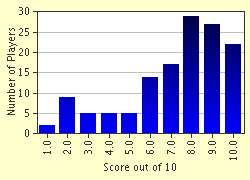Quiz Answer Key and Fun Facts
1. The first written mention of the Belgian people is in the book "De Bello Gallico" ("On the Gallic War"). The author explains at the very beginning of his book that "Horum fortissimi sunt Belgae" which means: "the Belgians are the bravest of all the Gauls". Who was this author?
2. One of the "brave Belgians" that fought against the Roman legions, was Ambiorix. This chieftain of a Belgian tribe persuaded 15 Roman cohortes (about 8,000 soldiers) to leave their heavily guarded garrison camp ... and then his tribe attacked and killed most of them. What tribe did Ambiorix command?
3. The Roman houses in Belgium were equipped with some kind of central heating during the second century A.D.
4. From 843 A.D till about 1011 A.D., the frontier between the feudal vassal territories owing allegiance to the nascent French kingdom and the German kingdom (later the Empire) respectively was formed partly by a Belgian river. Which river divided these vassal states?
5. Arnulf of Carinthia defeated a dreaded people near Leuven in 891 A.D.
Who were they?
6. Bishop Balderik II of Liège, count Lambrecht of Leuven and count Robert of Namur fought a battle in 1013 near a village that is very well known to lovers of Belgian beer. What village gave its name to this battle?
7. The First Crusade resulted in the capture of Jerusalem. The new "king" of Jerusalem was a Belgian nobleman. I have added quotation marks, because he didn't want to bear the title king: he chose the title "Protector of the Holy Sepulchre". Who was this Belgian nobleman?
8. The Flemish authorities and most of the major Flemish employers celebrate July 11th, in rememberance of the Battle of the Golden Spurs. In this battle, near Kortrijk, the army of the French king (about 6,500 soldiers, including cavalry and archery) fought a group of about 9,000 Flemish rebel infanteryman. Because the battlefield was quite marshy, the French heavy cavalry was hampered in its movements. Hence the Flemish infantryman were able to kill most of the French cavalry, and the rest of the French army fled. In what year did the Battle of the Golden Spurs take place?
9. One of the main squares in Ghent is dominated by the statue of the dean of the guild of cloth weavers (1290-1345), who opposed the French king and tried to start a revolt, with the aid of the English king Edward III. Who was this dean?
10. Two brothers were born in the Belgian city of Maaseik. The younger brother was an innovative portrait-painter, but experimented with some new techniques in landscape painting also. The eldest brother started the painting of "The Worship of the Lamb", that was completed by the younger brother. Who was this younger brother, who worked mainly in Ghent and Bruges?
Source: Author
JanIQ
This quiz was reviewed by FunTrivia editor
bloomsby before going online.
Any errors found in FunTrivia content are routinely corrected through our feedback system.

